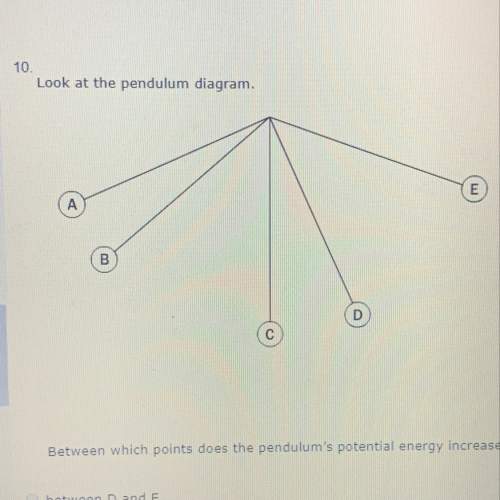

Answers: 1


Another question on Physics

Physics, 21.06.2019 17:20
American eels (anguilla rostrata) are freshwater fish with long, slender bodies that we can treat as uniform cylinders 1.0 m long and 10 cm in diameter. an eel compensates for its small jaw and teeth by holding onto prey with its mouth and then rapidly spinning its body around its long axis to tear off a piece of flesh. eels have been recorded to spin at up to 14 revolutions per second when feeding in this way. although this feeding method is costly in terms of energy, it allows the eel to feed on larger prey than it otherwise could. 1.a field researcher uses the slow-motion feature on her phones camera to shoot a video of an eel spinning at its maximum rate. the camera records at 120 frames per second. through what angle does the eel rotate from one frame to the next? 2. the eel is observed to spin at 14 spins per second clockwise, and 10 seconds later it is observed to spin at 8 spins per second counterclockwise. what is the magnitude of the eels average angular acceleration during this time? 3. the eel has a certain amount of rotational kinetic energy when spinning at 14 spins per second. if it swam in a straight line instead, about how fast would the eel have to swim to have the same amount of kinetic energy as when it is spinning? 4.a new species of eel is found to have the same mass but one-quarter the length and twice the diameter of the american eel. how does its moment of inertia for spinning around its long axis compare to that of the american eel?
Answers: 1

Physics, 21.06.2019 23:30
Aknife blade is a(n) a. lever b. screw c. wedge d. inclined plane
Answers: 2

Physics, 21.06.2019 23:30
Which lists the main components of darwin’s theory of evolution? a. random mutations drive evolution; the evolution of a population happens slowly; organisms have common ancestors; organisms do not change. b. natural selection drives evolution; the evolution of a population happens slowly; organisms have common ancestors; organisms change over time. c. natural selection drives evolution; the evolution of a population happens rapidly; organisms have common ancestors; organisms change over time. d. random mutations drive evolution; the evolution of a population happens rapidly; organisms have common ancestors; organisms do not change.
Answers: 1

Physics, 22.06.2019 07:30
Carbon-14 is a radioactive element that undergoes beta decay. which force is responsible for allowing carbon-14 to become stable? electromagnetic gravitational weak nuclear strong nuclear
Answers: 2
You know the right answer?
The strong force between nucleons has a magnitude of approximately 2.5×104N for two nucleons whose c...
Questions



Mathematics, 18.12.2020 18:40


English, 18.12.2020 18:40

Geography, 18.12.2020 18:40

Mathematics, 18.12.2020 18:40

Mathematics, 18.12.2020 18:40


History, 18.12.2020 18:40

Mathematics, 18.12.2020 18:40

Chemistry, 18.12.2020 18:40




Chemistry, 18.12.2020 18:40

English, 18.12.2020 18:40






